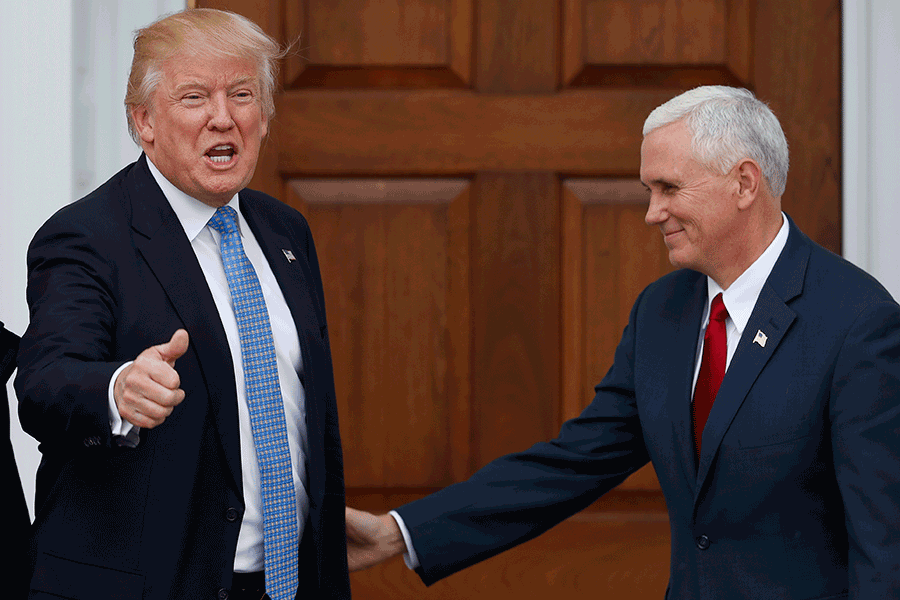Why Trump's popularity is rising
Loading...
President-elect Donald Trump’s approval ratings have shot up post-election, one new poll finds.
Forty-six percent of voters now have a very favorable or somewhat favorable opinion of the president-elect – up 9 points from pre-election, according to nonpartisan survey group Morning Consult. That’s despite an overall feeling of negativity surrounding his campaign, which appeared to affect voters on both sides of the party line.
But that’s not altogether unusual, analysts say. Approval ratings do tend to spike just after an election, even before the winning candidate takes office. We’re simply entering the “honeymoon period,” says Adam Berinsky, director of the Massachusetts Institute of Technology's political experiments research lab.
“I think part of it is about how political leaders talk about the new president,” Professor Berinsky tells The Christian Science Monitor in an email. “We move from a contentious election campaign where the negatives of both candidates are highlighted by their opponents, to a time where the losing candidate concedes and withdraws from the limelight. The balance of coverage then becomes more favorable and approval typically surges, even among the outparty.”
It’s also possible that the surge in support isn’t actual growth, but a willingness of Mr. Trump’s quieter supporters to be more vocal.
“The ‘surprise’ factions of support, such as white women, may now be willing to voice their approval when they previously might not have,” Tammy Vigil, a Boston University communications professor specializing in political campaign rhetoric, tells the Monitor.
Transition team building also plays an important role in the early ratings game. By carefully picking an inner circle, the president-elect can show leadership even before taking office.
“I think [Trump’s team] was caught a little bit off-guard – I don’t know if they really expected to win,” Joshua Sandman, a political scientist at the University of New Haven in Connecticut, tells the Monitor in a phone interview. “But now he’s into the swing of it, getting public recognition for his work and building a team. This ability of appearing to be somebody in charge, through building this team, is what’s making him rise in the ratings.”
About half of respondents in the Morning Consult poll said that Trump’s transition was as organized or more organized than previous administrations. That’s in spite of recent coverage surrounding the process, which has been described as rushed and disorganized. Notably, more than half of respondents said they had never heard of, or had no opinion about three of Trump’s top picks: chief of staff Reince Priebus, chief strategist Steve Bannon, or attorney general nominee Jeff Sessions.
“The election fatigue coupled by the heavy media attention paid to non-transition political news – the protests, the Hamilton fiasco, and so on – may keep folks from really considering the facts of the transition and they just assume it is going along in an orderly manner,” Ms. Vigil says.
“Most people don’t follow politics that closely – I don’t know that many people know who their own senators or local legislators are,” Mr. Sandman says. “The specifics are less significant than the visual aspect of the process.”
Some cognitive dissonance may have also played a role in the discrepancy. It’s possible that some Trump supporters aren’t ready to admit that there could already be serious problems in an administration that hasn’t even taken office yet.
“When they put so much energy into supporting the ‘outsider,’ they don't want to have to admit that filling key roles with long-time ‘insiders’ is a problem,” Vigil says. “Instead they explain away the discrepancies and avoid considering the implications. It is a common reaction.”
Of 1,885 registered voters surveyed, 12 percent had a somewhat unfavorable opinion of Trump. Thirty-four percent had a very unfavorable opinion. Traditionally, the winner is considered the preferred candidate of the people – only four previous presidents have won without the popular vote. That’s why many people, even those who vote against the winner, tend to keep high hopes for a peaceful transition of power.
The same may be true this cycle. According to a post-election survey by the Pew Research Center, about 58 percent of Clinton voters said they were willing to give Trump a chance.
Even still, this surge of support may not last long. Approval ratings usually dip not long after inauguration just as reliably as they spiked.
“Once the process of governing begins, this bounce typically fades as the opposition party picks up criticism and the media reports that criticism,” Mr. Berinsky says.
Even in the Morning Consult poll, which is somewhat more favorable for Trump than the Pew survey, the president-elect has a lower post-election approval rating than his predecessors going back decades.
“It will be interesting to see if his approval increases in advance of the inauguration – and if it doesn’t, whether it fades as quickly as other presidents,” Berinsky says. “It could be that we have an especially short honeymoon period. Perhaps a good deal of the opposition is already baked into the polls because of the contentious campaign.”
That narrative of divisiveness has become clearer than ever in the post-election data. Pew Research shows that voters had an unusually negative outlook during the 2016 campaign – not just toward candidates and party conventions, but also toward media outlets and even voters themselves.
“I should think that the best hope would be less emphasis on the differences between the hyperbolized versions of ‘melting snowflake liberals’ and ‘racist conservatives’ and more discussion of the actual shared needs of the people,” Vigil says. “Rather than amplifying divides, we need to plot out some shared goals and initiatives that can spotlight shared values.”








